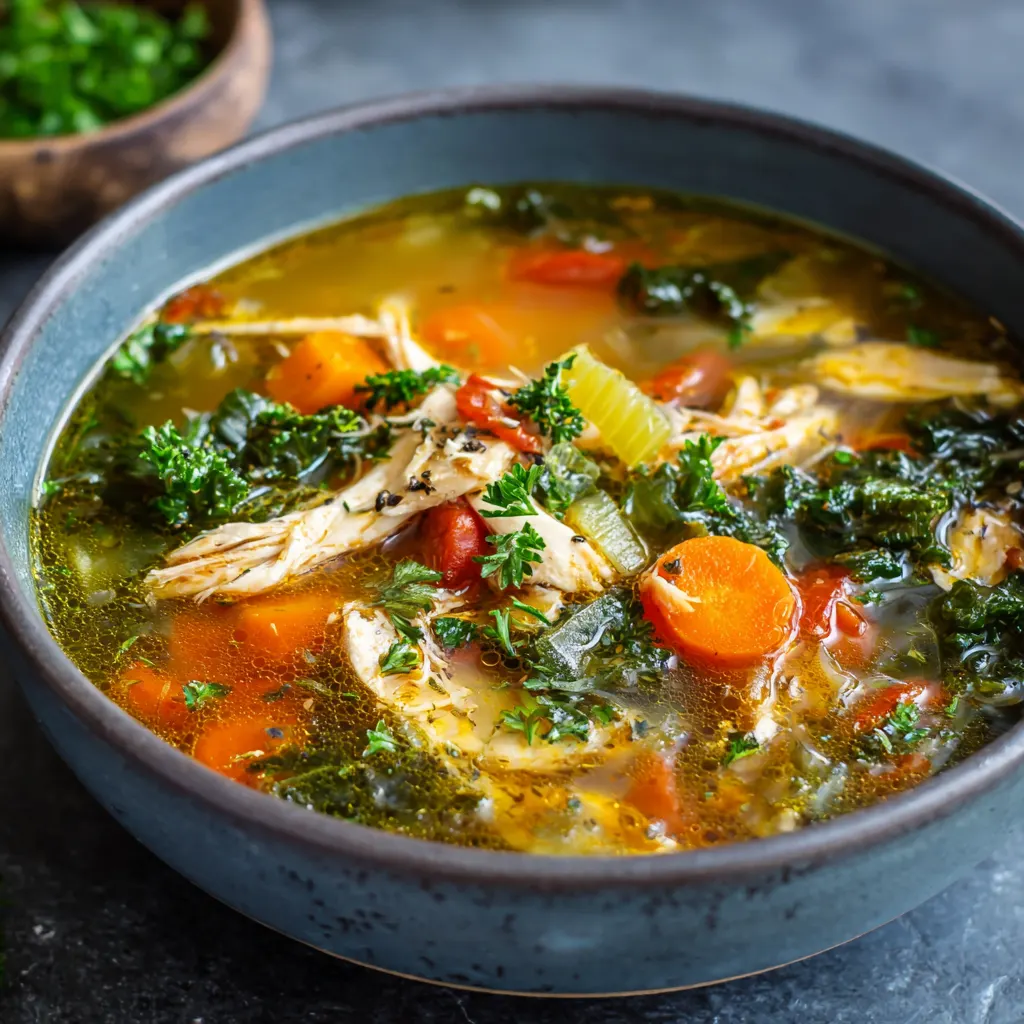Chicken soup has long been a favorite comfort food in homes worldwide. When crafted with a low carb focus, it transforms into a nutritious meal that supports healthy eating without sacrificing flavor. Family-friendly low carb chicken soup combines lean protein, wholesome vegetables, and savory broth to create a satisfying dish everyone can enjoy.
This soup works perfectly for families because it’s simple to prepare, packed with nutrients, and gentle on digestion. Kids and adults alike benefit from its warm, comforting nature, making it an ideal meal for busy weeknights or cozy weekends. Its low carbohydrate content helps maintain steady energy levels and supports weight management goals without feeling restrictive.
Low carb diets promote reduced carbohydrate intake, focusing on proteins and healthy fats. This approach can improve blood sugar control and boost overall health. Our chicken soup recipe fits perfectly within this lifestyle, offering a delicious way to enjoy a classic dish while staying true to low carb principles.
In this article, you’ll discover the benefits of low carb eating for families, learn about the best ingredients to use, and follow an easy step-by-step guide to making your own low carb chicken soup. We’ll also explore variations to suit different dietary needs and answer common questions. Finally, you’ll find a detailed recipe card to help you recreate this wholesome meal anytime. Let’s dive into the world of family-friendly low carb chicken soup and make healthy eating both simple and delicious.
What is a Low Carb Diet? Understanding Low Carb Eating and Its Core Principles
A low carb diet limits the intake of carbohydrates, focusing instead on proteins and healthy fats. Typically, daily carb consumption falls between 20 to 100 grams, depending on individual goals. By reducing carbs, the body shifts from using glucose for energy to burning fat, which can support weight loss and improve metabolic health.
Several popular low carb diets exist, each with unique guidelines. The ketogenic diet emphasizes very low carb intake, usually under 20 grams daily, to induce ketosis. The Atkins diet starts with strict carb limits and gradually increases them, promoting fat loss and muscle preservation. The paleo diet focuses on whole foods like lean meats and vegetables, excluding processed carbs and sugars. Each plan encourages nutrient-dense foods, making low carb diets versatile and adaptable to different lifestyles.
Health Benefits of Low Carb Eating for Families: Why It Matters for Everyone
Low carb diets offer many advantages for families seeking healthier lifestyles. First, they aid weight management by stabilizing blood sugar and reducing cravings. This can prevent overeating and promote fat loss in adults and children alike.
Second, regulating blood sugar helps lower the risk of type 2 diabetes and insulin resistance. Families with a history of these conditions may particularly benefit from a low carb approach. Improved blood sugar control also contributes to better mood and cognitive function.
Third, many people experience increased energy levels on low carb diets. By avoiding blood sugar spikes and crashes, the body enjoys steadier fuel throughout the day. This supports active lifestyles for both kids and adults, boosting focus and endurance.
Ultimately, low carb eating promotes overall health and wellness in families. It encourages whole, unprocessed foods while limiting sugars and refined carbs, making it a sustainable and balanced approach for all ages.
Why Choose Chicken Soup as a Low Carb Meal? Nutrient-Rich Comfort for the Whole Family
Chicken soup naturally fits low carb eating due to its combination of lean protein and non-starchy vegetables. Chicken supplies high-quality protein, essential for growth, repair, and immune support. Vegetables like zucchini, celery, and spinach add vitamins, minerals, and fiber with minimal carbs.
Beyond nutrition, chicken soup offers warmth and comfort, ideal for all seasons. Its easy digestibility makes it gentle on sensitive stomachs and appealing to picky eaters. Parents often find it an effective way to introduce healthy veggies to children without fuss.
Moreover, chicken soup’s versatility allows families to customize ingredients according to taste and dietary needs. Whether adding herbs for flavor or swapping vegetables, it adapts well without compromising its low carb benefits. This makes chicken soup a go-to meal for nourishing, satisfying family dinners.
Essential Ingredients for Low Carb Chicken Soup: Building Blocks for Flavor and Nutrition
Choosing the right ingredients is key to creating a family-friendly low carb chicken soup that tastes great and fuels your body. Start with chicken cuts like breast or thighs. Chicken breast is lean and high in protein, making it excellent for those watching fat intake. Thighs, while slightly higher in fat, offer richer flavor and tenderness that many families enjoy.
Next, add low carb vegetables that bring texture, color, and nutrients. Zucchini, spinach, celery, cauliflower, and mushrooms all work well. These vegetables are naturally low in carbohydrates but high in fiber and vitamins. They help bulk up the soup without adding excess carbs.
For the base, use chicken stock or bone broth. Bone broth adds extra minerals like calcium and magnesium, promoting joint and gut health. A rich broth enhances the soup’s depth without adding unnecessary carbs or calories.
Incorporate healthy fats such as olive oil, avocado oil, or butter. These fats improve the soup’s mouthfeel and increase satiety, helping keep everyone full longer. Plus, healthy fats support brain function and nutrient absorption.
Finally, season the soup generously with herbs and spices. Options like thyme, rosemary, parsley, garlic, and bay leaves add vibrant flavor without carbs. These natural seasonings enhance taste while keeping the soup wholesome.
Nutritional Breakdown: What Makes This Soup a Low Carb Powerhouse
This chicken soup delivers a robust amount of protein from the chicken, typically providing 20 to 30 grams per serving. Protein supports muscle repair and growth, essential for active family members of all ages.
Carbohydrates remain low, often under 10 grams per serving, thanks to the selective use of non-starchy vegetables. The fiber content from veggies boosts digestion and promotes gut health, which is especially important in family meals.
Micronutrients such as vitamin C, potassium, and iron come from both the vegetables and broth. These nutrients support immunity, hydration, and overall wellness.
Hydration plays a key role too. Because soup contains broth, it helps replenish fluids and electrolytes, which can prevent dehydration, especially during colder months or after physical activity.
Tips for Keeping the Soup Low Carb but Flavorful: Smart Swaps and Enhancements
Avoid adding high-carb thickeners like flour, cornstarch, or potatoes. These ingredients spike carbohydrate levels and counter the low carb goal. Instead, let the vegetables naturally thicken the soup as they cook down.
Boost flavor with herbs, spices, and umami-rich ingredients. Adding a Parmesan rind or a splash of miso paste can deepen the savory notes without adding carbs. These small touches elevate the soup’s taste, making it more appealing to all family members.
Balance fat and protein carefully to increase fullness. Including healthy fats alongside protein helps slow digestion and keeps hunger at bay. This balance makes the soup satisfying and supports sustained energy throughout the day.
By selecting nutrient-dense ingredients and smart flavor enhancers, you create a low carb chicken soup that nourishes your family without compromising on taste or health.
Step-by-Step Preparation Guide: Making Family-Friendly Low Carb Chicken Soup
Start by preparing the chicken. Rinse chicken breasts or thighs under cold water, then pat them dry with paper towels. Cut the chicken into bite-sized pieces to ensure even cooking and easy serving for kids. Season the pieces with salt, pepper, and any preferred herbs like thyme or rosemary to build flavor from the start.
Next, select your vegetables. Choose low carb options such as zucchini, celery, spinach, cauliflower, and mushrooms. Wash them thoroughly. Chop vegetables into uniform pieces to help them cook evenly. For example, dice zucchini and celery, roughly chop spinach, and slice mushrooms thinly.
If you want extra richness, prepare homemade chicken broth. Simmer chicken bones with onion, garlic, carrots, celery, and herbs in water for several hours. Strain the broth and use it as the base for your soup. Homemade broth adds deep flavor and nutrients, but you can use store-bought broth for convenience.
To cook the soup, heat olive oil or butter in a large pot over medium heat. Sauté onions and garlic until translucent, about 3 to 5 minutes. Add seasoned chicken pieces and brown lightly on all sides. Pour in the chicken broth and bring to a boil. Add the chopped vegetables and herbs like bay leaf and parsley. Reduce heat to low and simmer for 30 to 40 minutes. This slow cooking softens the veggies and melds flavors. Remove bay leaf before serving.
Variations and Adaptations for Families: Customizing Your Low Carb Chicken Soup
To make the soup more kid-friendly, add vegetables with mild flavors and fun textures. Carrots cut into small rounds, green beans, or finely chopped cauliflower work well. You can also puree part of the soup to create a creamy texture that picky eaters often prefer.
For dairy-free versions, skip butter and use olive or avocado oil. Ensure broth does not contain hidden dairy. To keep it gluten-free, verify that store-bought broth is free of gluten additives. For keto-friendly options, add more healthy fats such as a splash of heavy cream or coconut milk.
Use leftovers to save time. Shredded roast chicken or leftover vegetables from previous meals can be added directly to the broth. Canned or frozen low carb vegetables also work well in a pinch, making this soup quick and convenient for busy families.
Tips for Meal Prep and Storage: Making Low Carb Chicken Soup Work for Your Schedule
Making soup in bulk saves time and ensures you always have a healthy meal ready. Prepare a large batch and divide it into portion-sized containers for easy grab-and-go lunches or dinners.
When freezing soup, cool it completely before transferring to airtight containers or freezer bags. Label with the date and use within 3 months for best flavor. Thaw in the refrigerator overnight before reheating gently on the stove or microwave.
Portion control is important, especially for families with different age groups. Serve smaller bowls to children, adjusting vegetable and protein quantities accordingly. Offering the soup with low carb side options like a small salad can round out the meal and satisfy varying appetites.
By following these preparation, adaptation, and storage tips, you can consistently serve a delicious, nutritious low carb chicken soup that fits seamlessly into your family’s lifestyle.
FAQs About Family-Friendly Low Carb Chicken Soup
What vegetables are best for low carb chicken soup?
Choose non-starchy vegetables like zucchini, celery, spinach, cauliflower, mushrooms, and green beans. These add flavor, texture, and nutrients without raising carb content significantly.
Can I use frozen chicken or vegetables?
Yes, frozen chicken and vegetables work well and save prep time. Just thaw them safely before cooking. Frozen veggies retain most nutrients and cook quickly, making them convenient for busy families.
How can I make the soup creamier without adding carbs?
Use full-fat coconut milk, heavy cream, or blend part of the cooked vegetables into the broth. These options add richness without increasing carbohydrates.
Is this soup suitable for children on low carb diets?
Absolutely. This soup provides protein and essential nutrients while keeping carbs low. It’s gentle on young stomachs and can be customized with kid-friendly vegetables to suit picky eaters.
How long does the soup last in the fridge?
Store the soup in airtight containers for up to four days. Reheat gently on the stove or microwave. Always check for spoilage before consuming leftovers.
Can I add noodles or rice to this soup on a low carb diet?
Traditional noodles and rice are high in carbs and not recommended. Instead, use spiralized zucchini noodles (zoodles) or shirataki noodles for a low carb alternative.
What are good substitutes for chicken broth?
Bone broth offers extra nutrients and flavor. Vegetable broth is a good vegetarian option but check labels to avoid added sugars or carbs.
Can I use leftover roast chicken for this soup?
Yes, leftover roast chicken works great. It adds cooked protein and can speed up meal prep. Just shred the chicken and add it during the last 10 minutes of cooking to warm through.
These answers cover common concerns, helping you enjoy a delicious, healthy low carb chicken soup your family will love.
Family-Friendly Low Carb Chicken Soup – Healthy, Cozy & Easy

A hearty and healthy chicken soup loaded with low carb vegetables. This comforting dish is perfect for families seeking a nutritious and satisfying meal any day of the week.
Ingredients
- 1 lb chicken thighs or breast, diced
- 4 cups chicken broth (homemade or store-bought)
- 1 cup zucchini, diced
- 1 cup celery, chopped
- 1 cup spinach or kale
- 1 medium onion, chopped
- 2 cloves garlic, minced
- 2 tbsp olive oil or butter
- Salt and pepper to taste
- Herbs (thyme, parsley, bay leaf)
Instructions
Notes




